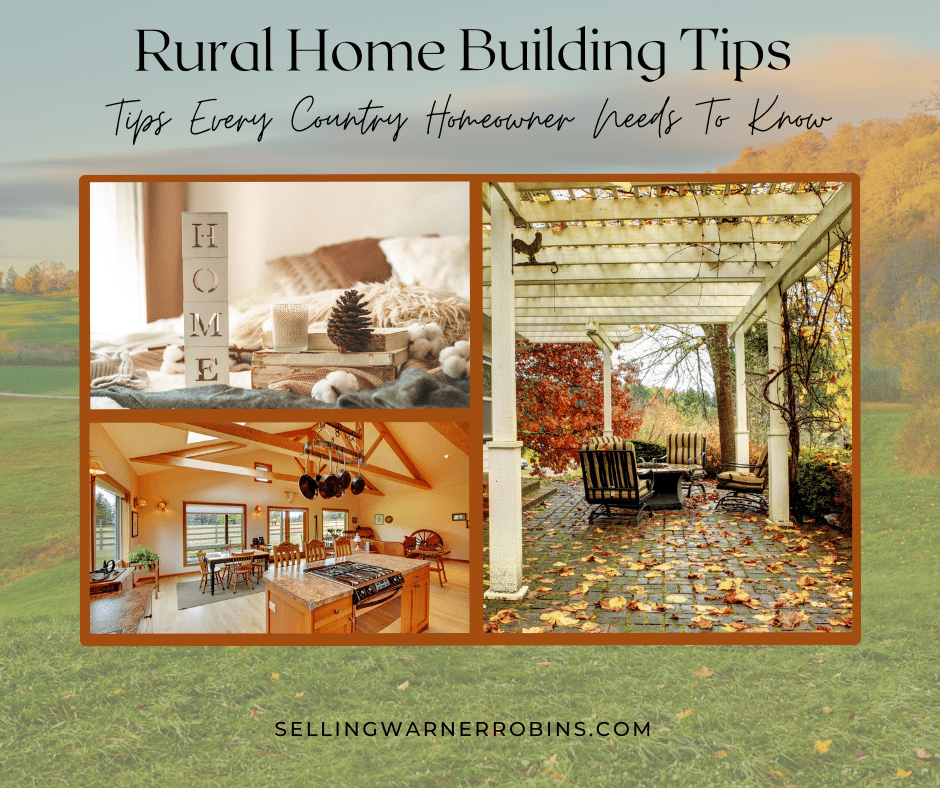Rural Home Building Tips Every Homeowner Should Know
Have you dreamed of building your dream home in a peaceful rural setting, away from the hustle and bustle of city life? While rural construction offers unique opportunities like lower property taxes and more space for customization, it also comes with challenges that require careful consideration. This article is chock full of rural home building tips so delve in!
Whether planning a modern farmhouse or a cozy countryside retreat, understanding the essentials of rural construction – from infrastructure needs to building codes and safety considerations – will help you create a beautiful and practical home. Follow these tips for purchasing rural properties for even more sage advice.

Rural Cost Benefits and Recent Trends
The rural housing market has seen remarkable shifts recently, with home prices increasing 30% in nearly two-thirds of rural counties during the pandemic. This dramatic change has created opportunities and challenges for those looking to build in these areas.
Despite the price surge, rural construction still offers significant financial advantages. Building costs in rural areas remain at around 77% of the national average, making it an attractive option for many homeowners. Here are some key financial advantages that make building in a rural area an appealing prospect:
- Lower property taxes and reduced land costs
- Fewer building restrictions and permit requirements
- More space for home customization and expansion
- Reduced labor costs compared to urban areas
While rural construction brings cost benefits, planning for specific infrastructure needs is essential. Installing a high-efficiency water booster pump for irrigation can help manage water supply effectively, which is crucial for rural properties.
The initial investment in such equipment often pays off through improved property functionality and long-term savings. A firm grasp of market dynamics and thoughtful planning can guide your rural construction project to success.
The combination of lower overall costs and strategic infrastructure investments creates a solid foundation for building your dream home in a rural setting.
Budget Planning and Construction Costs
Building your dream home in a rural area requires careful financial preparation, especially since home prices reached $665K for single-family homes in 2024. A solid budget strategy helps you avoid unexpected costs and keeps your project on track.
Rural construction often includes unique expenses that might not be obvious initially. Creating a detailed financial plan lets you account for these specific costs while controlling your investment.
To assist in this, here is a list of common expenses you’ll need to factor into your rural construction budget:
- Land preparation and site accessibility improvements
- Utility connections and infrastructure development
- Transportation costs for materials to remote locations
- Permits and inspections specific to rural areas
- Emergency fund for unexpected challenges
When scheduling your project, consider material prices, weather conditions, and contractor availability. Setting up a contingency fund for your budget provides a safety net for unforeseen expenses.
Breaking down your budget into clear categories helps track spending and maintain financial control throughout construction. Remember that rural builds often require specialized equipment and expertise, which should be factored into your initial cost estimates.
| Rural build planning: Create a prioritized checklist of rural-specific build requirements early in the planning phase so you can identify potential cost drivers and align them with your financing options. |
Selecting Experienced Builders for Rural Settings
Finding the right builder for your rural home project requires careful attention to detail and proper verification. Rural construction brings unique challenges that demand specific expertise and understanding.
A builder handling similar projects will know how to deal with limited access to materials, off-grid considerations, and special foundation requirements that often come with countryside properties.
Here’s what you should look for when choosing a builder for your rural project:
- Experience with similar rural construction projects
- Knowledge of local soil conditions and terrain challenges
- Strong relationships with reliable material suppliers in remote areas
- Valid licenses and proper insurance coverage
- Detailed portfolio of completed rural homes
- Positive references from previous rural clients
A qualified rural builder should demonstrate a clear understanding of off-grid solutions and be ready to handle unexpected challenges. They must coordinate with local authorities, manage material deliveries effectively, and ensure proper equipment access to your site.
Don’t hesitate to ask potential builders about their rural experience and how they’ve handled similar projects. Remember that a builder’s proven track record in rural construction is more valuable than a lower price tag – cutting corners in builder selection could lead to costly fixes.
Addressing Building Codes and Local Regulations
Building in rural areas comes with unique challenges, especially when formal building codes vary or are absent. However, adhering to proper building standards is essential for ensuring your home’s safety and long-term durability, so choose a reputable contractor and always check out referrals.
While some rural areas might have relaxed rules, building by recognized standards will protect your investment and create a safe living environment.
To navigate these complexities and ensure your rural home meets necessary safety and quality benchmarks, consider the following:
- Request detailed documentation of all building standards that apply to your specific location
- Work with professionals who understand International Building Code standards
- Get written confirmation from local authorities about required permits and inspections
- Keep records of all compliance-related communications and approvals
- Consider hiring a third-party inspector to verify construction quality
Your local county planning office should be your first stop for guidance on construction requirements. They’ll help clarify which building standards apply and what permits you need.
Don’t hesitate to ask questions about everything from foundation requirements to electrical specifications. Many rural homeowners find that working closely with county officials early helps prevent costly corrections later.
Remember that mortgage lenders and insurance companies often have their construction requirements, even if local codes are minimal. Meeting these standards isn’t just about following rules – it’s about creating a home built to last and maintaining its resale value for years.
| Secure smart building: Building without verified standards in rural areas can expose homeowners to long-term safety issues and financing complications, making proactive compliance a wise investment in security and future marketability. |
Utility Planning and Site Access Considerations
Reliable road access and proper utility systems form the backbone of a successful rural home build. Before breaking ground, checking if your property has year-round road access for construction equipment and daily use is essential. Consider how weather conditions affect these access points, especially during harsh seasons.
Water and wastewater management need special attention in rural settings. Since you won’t have city services, you must plan for a private well and septic system.
An irrigation booster pump can help maintain consistent water pressure throughout your property, making it easier to handle household and outdoor needs.
Key Infrastructure Elements to Evaluate Before Starting Construction
- Well placement and water quality testing requirements
- Septic system location and soil percolation test results
- Power line extensions or alternative energy options
- Internet and communication service availability
- Natural gas availability or propane tank installation needs
Early infrastructure planning can save you from costly fixes later. Start by getting a professional assessment of your site’s existing utilities and what you’ll need to add.
Bringing utilities to remote locations can significantly impact your budget, so factor these costs into your initial planning phase. Many rural homeowners find that installing utilities can take several months, which should be built into your construction timeline.
Prioritizing Health and Safety Issues
Taking care of your family’s health starts with understanding potential hazards on your rural property. Natural risks like flooding, soil erosion, or unstable ground conditions need careful evaluation before construction begins.
Your drinking water quality and sanitation systems deserve special attention, as they are crucial for maintaining a healthy living environment.
Checklist Before Building Your Rural Home
- Soil testing to identify any contamination or stability issues
- Water source quality assessment and treatment options
- Natural drainage patterns to prevent moisture problems
- Local wildlife presence that might affect safety measures
- Emergency response accessibility to your property
Consider installing reliable safety features that work well in rural settings. A proper ventilation system helps maintain good indoor air quality, which is critical if you’re in an area prone to wildfires or agricultural dust.
Incorporating a backup power system is beneficial since rural areas often face more frequent outages than urban locations.
Remember to plan for the future by including safety features that will serve you well as your needs change. Smart home monitoring systems can help you monitor everything from water quality to security, giving you peace of mind even when you’re away from your rural property.
| Rural Safety Zone: Consider creating a dedicated safety zone on your property with essentials like first-aid supplies, fire extinguishers, and maps for family emergency plans, tailored to the unique challenges of rural living. |
Designing for Comfort, Efficiency, and Resilience
Your rural home should be a comfortable sanctuary that stands firm against nature’s challenges. Creating a resilient living space means thinking beyond basic comfort—it’s about making smart choices that will keep your home running smoothly for years to come.
Energy-efficient features are not just trendy additions; they are essential elements that will help cut your monthly bills and protect against rural power fluctuations.
- Install double-paned windows and high-quality insulation to maintain indoor temperatures
- Add solar panels or wind energy systems for backup power during outages
- Choose durable, weather-resistant materials for exterior construction
- Include a whole-house generator to ensure a continuous power supply
- Design wider doorways and zero-step entries for accessibility
While planning your home’s layout, consider the unique challenges of rural living. A mudroom can keep dirt and debris from spreading throughout your house, while a dedicated storage space helps manage supplies during weather-related isolation.
Consider including a flexible space that can adapt to your changing needs—whether it’s a home office today or an in-law suite tomorrow.
Remember to position your main living areas to take advantage of natural light and ventilation, reducing your reliance on artificial heating and cooling systems.
| Resilient living design: A resilient home is purposefully designed to adapt, endure, and recover from environmental stresses, prioritizing long-term stability, safety, and self-sufficiency in its structure and systems. |
Evaluating Proximity to Services and Quality of Life
Living in rural areas can be peaceful and rewarding, but it’s smart to consider how far you’ll be from essential services before building your home.
Proximity to hospitals, fire stations, and emergency services is essential for your family’s safety and peace of mind.
Rural life often means trading quick access to amenities for more space and tranquility. Still, you’ll want to map out the locations of essential services you need regularly.
Here are key considerations to evaluate before choosing your building site:
- Distance to medical facilities and emergency services
- Access to grocery stores and daily necessities
- Travel time to schools if you have children
- Proximity to your workplace or reliable internet for remote work
- Location of community centers and social gathering spaces
Your quality of life depends heavily on finding the right balance between rural charm and practical needs. Think about your daily routines and how they might change in a rural setting.
Some homeowners love growing their food and enjoy the slower pace, while others might find the distance from urban amenities challenging. Consider your long-term lifestyle goals and how they align with the rural environment you plan to call home.
Building Your Rural Dream
Building a rural home requires careful consideration of unique challenges, from infrastructure needs to local regulations, but the rewards of countryside living make it worthwhile.
The key to success lies in thorough planning, understanding the costs, and partnering with experienced professionals who understand rural construction’s specific demands.
Remember that while rural building might seem overwhelming at first, taking it step by step with proper research and preparation can lead to creating your perfect countryside sanctuary.
If you found this article on rural home building tips helpful, please share the article so more consumers can benefit from the information provided.
Rural Home Building Tips For Buyers
About Anita Clark Realtor
Anita Clark has written 687 posts on this blog.
by Anita Clark Anita is a residential Real Estate Agent in Warner Robins Georgia, with Coldwell Banker Access Realty (478) 953-8595, aiding buyers and sellers with all their real estate questions on her Warner Robins blog.



